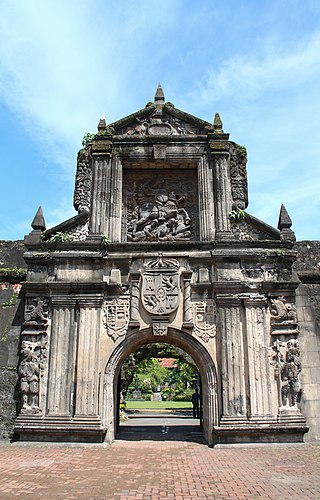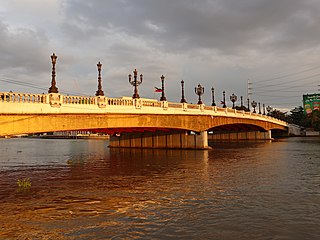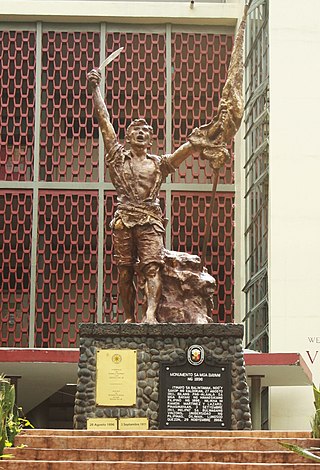
Intramuros, is the 0.67-square-kilometer (0.26 sq mi) historic walled area within the city of Manila, the capital of the Philippines. It is administered by the Intramuros Administration with the help of the city government of Manila.

Fort Santiago, built in 1571, is a citadel built by Spanish navigator and governor Miguel López de Legazpi for the newly established city of Manila in the Philippines. The defense fortress is located in Intramuros, the walled city of Manila.

The Church of Saint Augustine, also known as the Archdiocesan Shrine of Our Lady of Consolation and Cincture or the Immaculate Conception Parish, is a Roman Catholic church under the auspices of the Order of Saint Augustine located inside the historic walled city of Intramuros in Manila, Philippines. Completed in 1607, it is the oldest stone church in the country.

Rizal Park, also known as Luneta Park or simply Luneta, is a historic urban park located in Ermita, Manila. It is considered one of the largest urban parks in the Philippines, covering an area of 58 hectares. The site on where the park is situated was originally known as Bagumbayan during the Spanish colonial period. It is adjacent to the historic Walled City of Intramuros.

Carlos María de la Torre y Navacerrada (1809–1879) was a Spanish soldier and politician. He served as Governor-General of the Philippines from 1869 to 1871, and is considered one of the most beloved Spanish Governors-General assigned to the Philippines.
The gates of Intramuros refer to the original eight gates of the Walled City of Intramuros in Manila, built during the Spanish colonial era in the Philippines. The gates are called by the original Spanish word for "gate", puerta.

The University of Santo Tomas is one of the oldest existing universities and holds the oldest extant university charter in the Philippines and in Asia. It was founded on April 28, 1611, by the third Archbishop of Manila, Miguel de Benavides, together with Frs. Domingo de Nieva and Bernardo de Santa Catalina. It was originally conceived as a school to prepare young men for the priesthood. Located Intramuros, it was first called Colegio de Nuestra Señora del Santísimo Rosario and later renamed Colegio de Santo Tomás in memory of Dominican theologian Saint Thomas Aquinas. In 1624, the Colegio was authorized to confer academic degrees in theology, philosophy and arts. On November 20, 1645 Pope Innocent X elevated the college to the rank of a university and in 1680 it was placed under royal patronage.

The William A. Jones Memorial Bridge, commonly known as the Jones Bridge, is an arched girder bridge that spans the Pasig River in the City of Manila, Philippines. It is named after the United States legislator William Atkinson Jones, who served as the chairman of the U.S. Insular Affairs House Committee which had previously exercised jurisdiction over the Philippines and the principal author of the Jones Law that gave the country legislative autonomy from the United States. Built to replace the historic Puente de España in the 1910s, the bridge connects Quintin Paredes Road at the Binondo district to Padre Burgos Avenue at the Ermita district.

Historical markers are installed by the National Historical Commission of the Philippines (NHCP) in the Philippines and places abroad that signify important events, persons, structures, and institutions in Philippine national and local histories. The plaques themselves are permanent signs installed by the NHCP in publicly visible locations on buildings, monuments, or in special locations. Local municipalities and cities can also install markers of figures and events of local significance. Though they may have the permission of the NHCP, these markers are barred from using the seal of the Republic of the Philippines.

Plaza de Roma, also known as Plaza Roma, is one of three major public squares in Intramuros, Manila. It is bounded by Andres Soriano Avenue to the north, Cabildo Street to the east, Santo Tomas Street to the south, and General Antonio Luna Street to the west. The plaza is considered to be the center of Intramuros.

Plaza San Lorenzo Ruiz or Plaza Lorenzo Ruiz is a major public square in Binondo, Manila, bounded by Quintin Paredes Street to the east and Juan Luna Street to the west, parallel to the Estero de Binondo. It is the plaza that fronts the Minor Basilica of San Lorenzo Ruiz, one of the main churches of the City of Manila, and is considered the center of Binondo as a whole.

The Anda Monument, often erroneously referred to as the Anda Circle after the roundabout it is currently located, is an obelisk monument situated in the boundary of Intramuros and Port Area in central Manila, Philippines. It was erected in honor of Simón de Anda y Salazar, the Governor General of the Philippines from 1770 to 1776. The Anda Circle, the roundabout, is an interchange system at the junction of Bonifacio Drive, Mel Lopez Boulevard, Andres Soriano Avenue, and Roberto Oca Street.

The Liwasang Bonifacio, also known by its former name, Plaza Lawton, is a city square and transport hub in front of the Manila Central Post Office in the Ermita district of Manila, Philippines. It lies at the south end of Jones Bridge, MacArthur Bridge, and Quezon Bridge that link the northern districts of Binondo, Santa Cruz, and Quiapo to the central district of Ermita. The plaza straddles the dividing line between Ermita and Intramuros and is the starting point of Padre Burgos Avenue which connects to Taft Avenue and Roxas Boulevard in Rizal Park.
Plaza Mexico is a historic riverside square in Manila, Philippines, located at the west end of Magallanes Drive and Riverside Drive in Intramuros bordering the Pasig River in the north. It is surrounded by the Aduana Building on the south, the Bureau of Immigration Building on the east and the ruins of the Bastión de Maestranza and Puerta de Almacenes on the west. The Pasig River Ferry has a station also named Plaza Mexico located northeast of the square behind the Immigration building. The square was named Plaza Mexico in 1964 to commemorate the 4th centenary of the expedition of Miguel López de Legazpi and Andres de Urdaneta from New Spain (Mexico) and the historic Manila-Acapulco galleon trade relations between the two nations that lasted 250 years.

Plaza de España, also known simply as Plaza España, is a diminutive open space in Intramuros, Manila, Philippines formed by the intersection of Andres Soriano Avenue, Solana Street and Muralla Street. It is a triangular "square" which features a monument to King Philip II of Spain after whom the Philippines was named. The square is one of 47 parks and plazas in the City of Manila maintained by the city's Park Development Office in partnership with the Intramuros Administration. It is surrounded by the Aduana Building, the BPI Intramuros building which replaced the old Santo Domingo Church destroyed during World War II, and the Banco Filipino condominium building built on a portion of the old Ayuntamiento de Manila.
José Julián de Aranguren was an Augustinian missionary who served as Archbishop of Manila from 1847 to 1861. He is the 22nd Archbishop of the Philippine archdiocese of the Latin branch of the Catholic Church.

The Benavides Monument is a memorial in the University of Santo Tomas in Manila, Philippines built to commemorate the founder of the University of Santo Tomas, Miguel de Benavides, O.P. Located in front of the UST Main Building, the monument consists of a bronze statue of Benavides rising on top of a granite pedestal. The present monument was unveiled in 1946.

The Monument to the Heroes of 1896 is a sculpture created in 1911 dedicated to the Philippine Revolution.

The Rizal Monument is a memorial in Madrid, Spain built to commemorate José Rizal, an executed Filipino nationalist regarded as a national hero of the Philippines. Located at a corner of the Parque de Santander along the Avenida de Filipinas in the district of Chamberí, the monument is a near-exact replica of Motto Stella, the monument erected in Rizal's memory near his execution site at the modern-day Rizal Park in Manila.


















